Table Of Contents
- Interaction of Display into Smart Internet of Things
- Progress in Display Technology
- Adoption of Advanced Display Technologies across Industries
- Incorporation of Advanced Display Technologies in Government and Public Infrastructure
- Industry Players and Innovations
- Case Study: The Evolution of Retail with Smart Display Technology
- Final Lines

Onkar Sumant

Koyel Ghosh
Revolutionizing Visual Experiences- Innovations in Display Technology across Various Industries

Display Technology advancements are transforming visual experiences in a variety of industries. 4K and 8K high-resolution displays give excellent image quality for both entertainment and professional use, while OLED and Mini-LED technologies deliver higher contrast and deeper blacks. Meanwhile, the introduction of bendable, flat panel displays, and see-through screens are providing new perspectives on design and interaction, while advances in virtual/augmented reality have transformed industries such as education, gaming, and healthcare. These advancements, together with energy-efficient and long-lasting displays, are redefining visual communication constraints to create experiences that were previously unimaginable.
Over the previous decade, the digital display sector has undergone significant developments. The business dynamics changed noticeably between 2010 and 2021. On the other hand, income from IT panels increased from 20% to 29% because of developments such as MiniLED, while TV market share increased by just around 2% to 28%, and average screen sizes increased significantly to 47 inches. Despite a decline in mobile phone panel share from 38% to 30%, it remains the largest sector ever. In terms of sales share, BOE led all panel suppliers with 19.1% in 2021, while SDC maintained its supremacy in flexible smart OLED panels with a large share of 59%.
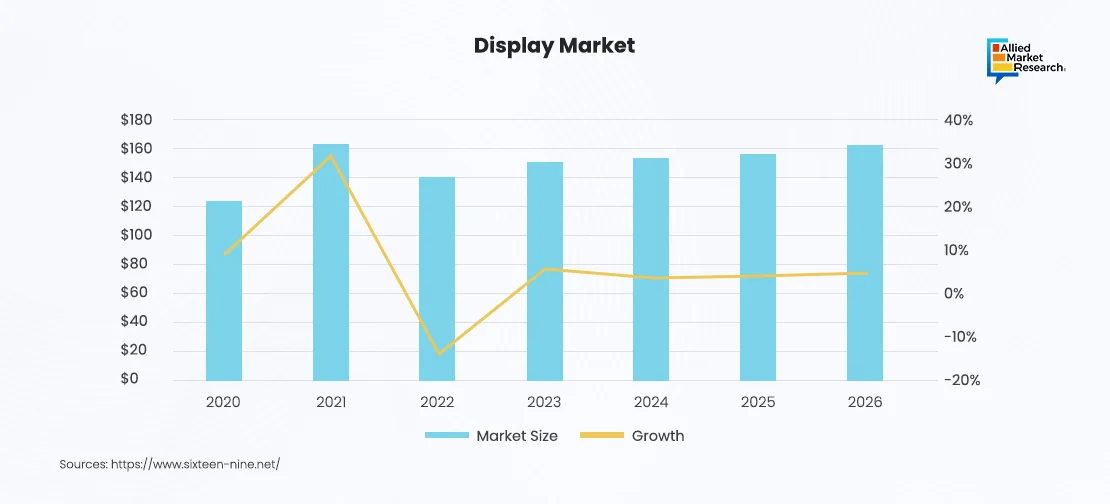
The period between the pandemic years of 2020 and 2021 witnessed exceptional growth in sales of up to $164 billion, fueled by work-from-home and learn-from-home technologies, resulting in notebook sales growing by about 100 million units. However, issues such as overinvestment resulting in oversupply, price decreases, and weaker margins began to emerge in 2022. The global recovery, combined with rising inflation, worsened these issues, causing disruptions in supply chains and higher energy prices in the sector. Even so, it is progressively moving toward automotive applications, paired with advanced display technologies that expect severe rivalry and innovation in the future.
Digital signage and digital billboards have seen a significant increase in usage, offering advertisers the ability to deliver targeted and impactful messages in high-traffic areas, capturing the attention of consumers on the move. With advancements in technology, such as personalized and interactive ad experiences, as well as immersive formats like augmented reality (AR) and virtual reality (VR), advertisers can create memorable and engaging campaigns that resonate with their target audience.
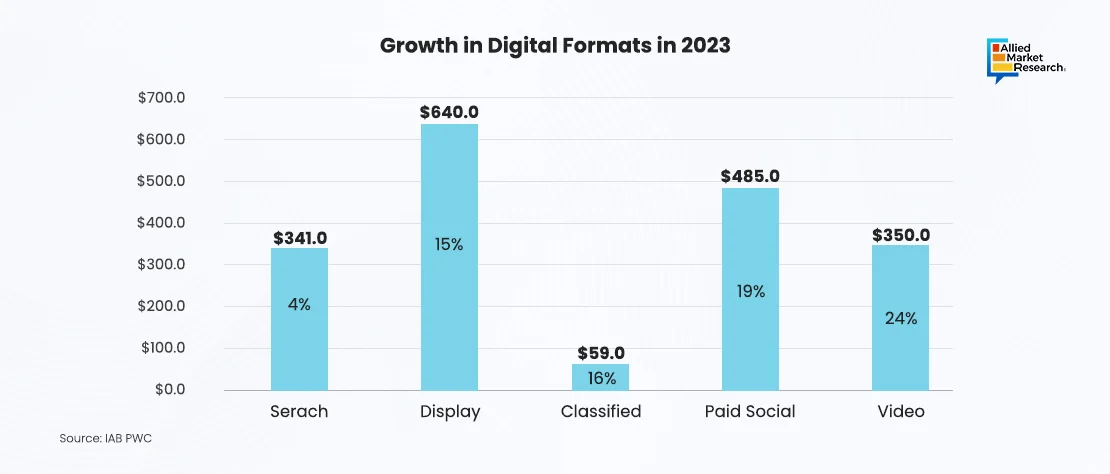
In 2023, display advertising, which includes paid social, rose by 15% over $600 million over the previous year. This growth was mostly driven by a 24% increase in video commercials, which amounted to more than $350 million. Furthermore, there was a considerable surge in digital audio, which increased by 16%, contributing to the success of display commercials. Display advertising component known as paid social exhibited tremendous resilience and growth shooting up by almost a fifth (19%) above $ 480 million. Amidst this growth, emerging trends such as personalized and interactive ad experiences, programmatic advertising, and immersive formats like augmented reality (AR) and virtual reality (VR) are reshaping the landscape, ensuring continued innovation and engagement in the display advertising sector.
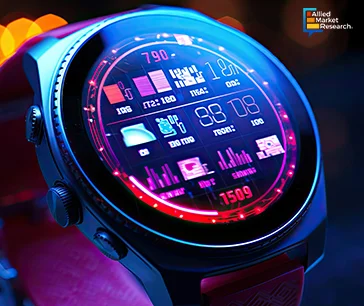
Interaction of Display into Smart Internet of Things
The Internet of Things (IoT) and display technologies are redefining human-machine interaction and changing the way information is delivered to people. Smart screens have evolved from passive displays to platforms that interact with both humans and the environment via sensors and networking. This fusion also opens the idea of deploying such screens as central hubs for managing smart devices, tracking data, and providing personalized services.
The integration of IoT and display technologies already has an impact on various industries. In smart homes, displays are used to manage lighting, temperature, and security systems, among other things, serving as control panels. The integration of IoT into industrial displays allows real-time visualization of machine/sensor data which supports predictive maintenance and improves production processes. Retail establishments on the other hand employ clever displays that preside over bespoke product suggestions and focused advertising based on contextual knowledge for the ultimate customer experience. Furthermore, the emergence of next generation display technology, such as touchscreens, voice recognition, and gesture control, further augments the seamless interaction between users and IoT devices. As the IoT continues to expand, the integration of display technology is poised to play a pivotal role in shaping the future of connected devices and smart environments. This symbiotic relationship will foster innovation, improve efficiency, and enhance the user experience across various industries and applications.
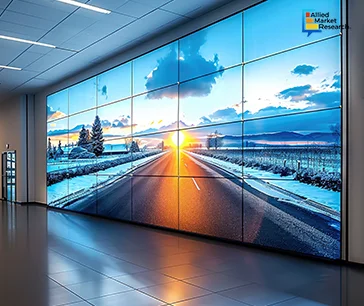
Progress in Display Technology
Advancements in display technology have revolutionized visual communication, enhancing image quality, energy efficiency, and interactivity. Quantum dot displays offer wider color gamut and greater brightness, while OLED technology enables thinner, flexible screens with true blacks and vibrant colors. Mini-LED backlighting enhances contrast and local dimming for improved HDR performance. High refresh rate displays provide smoother motion for gaming and video content. Touchscreen technology enables intuitive interaction with devices and digital signage. These advancements, coupled with energy-efficient materials and manufacturing processes, are not only transforming consumer electronics but also revolutionizing industries like healthcare, education, and advertising.
Adoption of Advanced Display Technologies across Industries
The adoption of cutting-edge display technologies is rapidly expanding across diverse industries. In healthcare, high-resolution medical displays enable accurate diagnosis and surgical visualization, while interactive displays enhance patient engagement. Education benefits from interactive whiteboards and virtual reality headsets that create immersive learning experiences. Retail embraces digital signage and transparent displays to captivate customers and enhance the shopping journey. Transportation hubs utilize large-scale displays for passenger information and wayfinding. Even the automotive industry is incorporating advanced displays into dashboards and infotainment systems. This widespread adoption is driven by the need for enhanced communication, improved productivity, and a more engaging user experience.
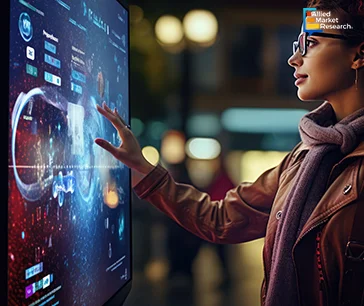
Incorporation of Advanced Display Technologies in Government and Public Infrastructure
The adoption of advanced display technologies in government and public infrastructure is driven by the need for enhanced communication, improved operational efficiency, and elevated user experiences. High-resolution displays and interactive kiosks provide clear and accessible information in public spaces like airports, train stations, and government offices. Large format displays in control rooms enable real-time monitoring of critical infrastructure, aiding in decision-making and emergency response. Additionally, digital signage networks offer dynamic and targeted messaging for public awareness campaigns and information dissemination. The integration of display technology with other systems, such as building management systems and security cameras, enhances operational efficiency and situational awareness. By investing in advanced display solutions, government, and public institutions demonstrate their commitment to modernization and efficient service delivery, fostering public trust and satisfaction.
The Singapore government launched the Smart Nation Sensor Platform, an ambitious project to turn the city into a data-driven urban environment, in May 2024. This integrated system combines thousands of cameras, environmental sensors, and other data sources with a centralized command center featuring large-scale, high-resolution displays. These displays provide real-time visualizations of citywide data, including traffic patterns, air quality, energy consumption, and crowd density. This comprehensive overview empowers government agencies to make informed decisions for urban planning, resource allocation, and emergency response, ultimately enhancing the quality of life for residents and optimizing the city's infrastructure.
In December 2023, the Dubai Roads and Transport Authority (RTA) unveiled a network of interactive digital signage displays across all Dubai Metro stations. These state-of-the-art displays offer a seamless and engaging experience for passengers, providing real-time updates on train schedules, platform information, and service disruptions. Additionally, the interactive kiosks allow passengers to access maps, plan journeys, and purchase tickets, enhancing the overall convenience and efficiency of public transportation. The initiative also incorporates local news updates, weather forecasts, and cultural information, making the metro stations informative and engaging hubs for commuters.
The U.S. Department of Transportation (DOT) announced a major investment in a national program to install smart traffic signs with integrated displays in August, in the same year. These intelligent signs support real-time data from traffic sensors, cameras, and weather monitoring systems to provide drivers with dynamic and context-aware information. The displays can show current traffic conditions, warn of accidents or road hazards, and provide alternative route suggestions. Additionally, they can display weather alerts and Amber Alerts for missing children, enhancing safety and situational awareness for drivers. The DOT's initiative aims to improve traffic flow, reduce congestion, and create a safer driving environment for all road users.
On a similar note, in May 2023, the UK government initiated a collaborative effort with major airports to strengthen border security by implementing advanced facial recognition technology. This cutting-edge technology utilizes high-resolution displays to capture and analyze facial biometrics, streamlining passenger identification and reducing wait times at immigration checkpoints. The system compares travelers' faces to passport photos and security databases, ensuring accurate and efficient verification. This initiative not only enhances security but also improves the overall passenger experience by expediting the border control process.
Industry Players and Innovations
The display market is highly competitive due to the strong presence of existing manufacturers. The existing manufacturers in the market, with extensive financial and technical resources, are anticipated to gain a competitive advantage over other manufacturers as they cater to the industry's demands. The leading players in the domain are focusing on technological innovation and adapting advanced technologies during the launch of products. For instance,
In February 2024, Samsung Electronics Co., Ltd. introduced "The Wall," a groundbreaking modular MicroLED display designed for both commercial and luxury residential applications. This innovative technology utilizes microscopic LED lights to deliver unparalleled picture quality, with vibrant colors, deep blacks, and exceptional brightness. The Wall's modular design allows for customizable sizes and resolutions, making it adaptable to various environments, from corporate lobbies and retail spaces to home theaters and private residences. Samsung aims to redefine visual experiences with The Wall, offering a seamless and immersive display solution that pushes the boundaries of technology.
LG Display, a leading innovator in display technology, announced a strategic partnership with Mercedes-Benz AG, the renowned luxury automotive manufacturer, in November 2023. The collaboration focuses on developing cutting-edge in-vehicle displays for Mercedes-Benz's next-generation electric vehicles . These advanced displays will leverage LG Display's expertise in OLED and LCD technologies, offering drivers and passengers enhanced visuals, intuitive controls, and personalized experiences. The partnership aims to transform the way people interact with their vehicles, making journeys more informative, entertaining, and safe.
Case Study: The Evolution of Retail with Smart Display Technology
Background: FashionFusion, a global fashion retail leader, faced stagnant growth and sought to revitalize its brick-and-mortar stores by embracing digital innovation. The company recognized the potential of smart displays to enhance customer experience, streamline operations, and ultimately drive sales.
Challenges: Traditional static displays limited customer interaction, leading to missed product discovery and engagement opportunities. Outdated inventory management systems resulted in frequent stockouts and overstocks, causing customer frustration and lost revenue. Moreover, the lack of personalized shopping experiences prevented the brand from differentiating itself from its competitors.
Solution: FashionFusion embarked on a comprehensive digital transformation, integrating interactive mirrors in fitting rooms, strategically placing digital signage throughout the store, and developing a mobile app that seamlessly connected with in-store inventory. This comprehensive approach aimed to utilize technology to address the identified challenges and create a truly modern shopping experience.
Benefits: The interactive mirrors revolutionized the fitting room experience, allowing customers to virtually try on clothes in different sizes and colors, explore complementary accessories, and even request assistance from store associates without leaving the room. Digital signage captivated shoppers with dynamic content, showcasing new arrivals, personalized recommendations based on their browsing history, and eye-catching promotions. Real-time inventory updates on displays and the mobile app ensured that customers had accurate information about product availability, eliminating the frustration of stockouts and improving overall satisfaction. Additionally, the integrated system collected valuable customer data, providing insights into preferences and shopping patterns, enabling FashionFusion to refine its marketing strategies and deliver personalized offers.
Results: Within six months of implementing the smart display solution, FashionFusion experienced remarkable results. Sales increased by 15%, directly attributed to the enhanced customer engagement and personalized experiences facilitated by technology. Customer satisfaction ratings soared by 20%, reflecting the positive impact of the seamless shopping journey. The company also witnessed a 10% reduction in product returns, as customers were able to make more informed decisions in the virtual fitting room. Furthermore, the data collected through the system provided valuable insights into customer behavior, allowing FashionFusion to optimize inventory levels and tailor marketing campaigns, leading to increased efficiency and profitability.
Conclusion: FashionFusion's embrace of smart display technology revitalized its retail presence, showcasing how digital innovation transforms the fashion industry. By addressing customer pain points, improving operational efficiency, and delivering personalized experiences, the company achieved significant business growth and secured its position as a leader in the ever-evolving retail landscape.
Final Lines
Display technology has led to significant changes in visual experiences across a wide range of sectors. Improvements in 4K and 8K displays, OLED, Mini-LED, and smart IoT integration have set new standards for image quality, interaction, and design. These advancements are transforming healthcare, retail, and transportation industries by improving operational efficiency and encouraging user participation. Visually captivating! From smartphones and TVs to laptops and wearables, the display market showcases the pervasive impact of these innovations.
Allied Market Research (AMR) serves as a trusted partner for vendors in the display market, offering comprehensive insights and tailored strategies to effectively utilize display technologies in various sectors, including residential buildings, commercial sectors, public infrastructure, educational institutions, industrial, and others. With AMR's expertise and support, businesses can gain the knowledge and tools needed to identify opportunities, assess market demand, and drive innovation in display technology operations. Vendors can gain valuable insights into leading display manufacturers, their strategies, and key developments by utilizing AMR's in-depth insights. For more details about technologies, innovations, and dynamics in the display industry, contact our specialists today!

